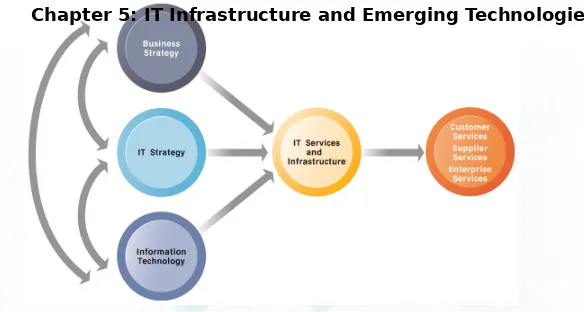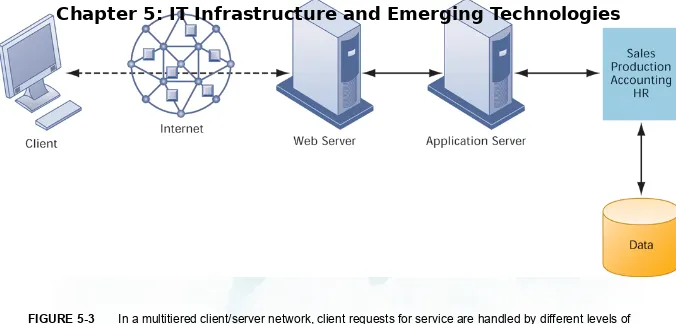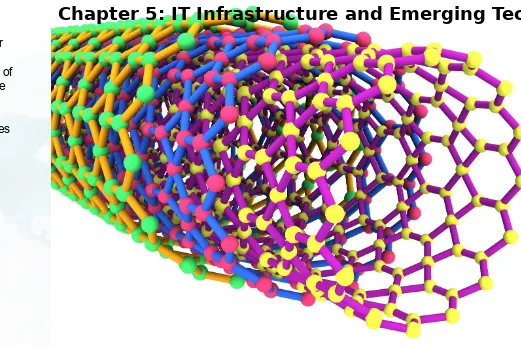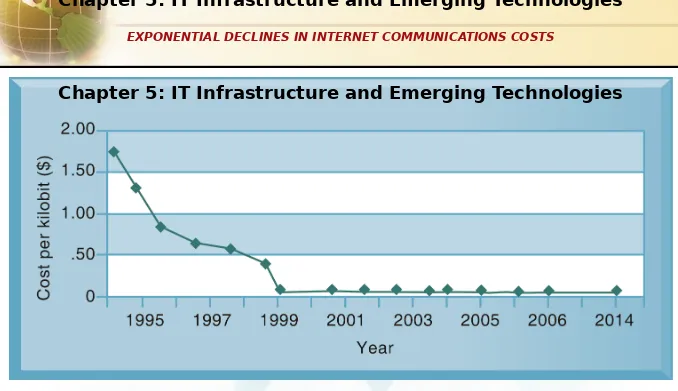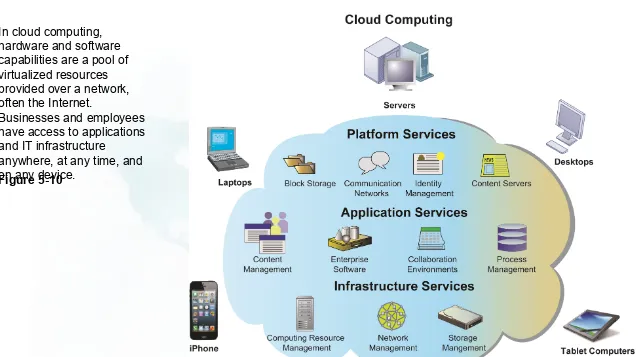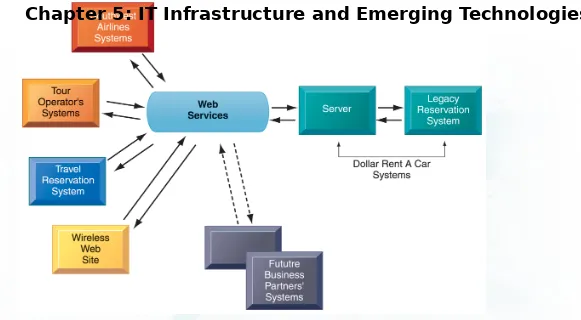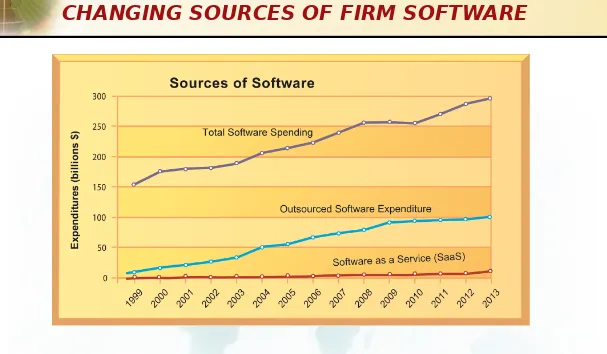IT Infrastructure and
Emerging Technologies
Chapter 5
Management Information Systems
Chapter 5: IT Infrastructure and Emerging Technologies
•
What is IT infrastructure and what are the
stages and drivers of IT infrastructure
evolution?
•
What are the components of IT
infrastructure?
•
What are the current trends in computer
hardware platforms?
•
What are the current trends in computer
software platforms?
Management Information Systems
Chapter 5: IT Infrastructure and Emerging Technologies
•
Problem:
Providing a consistent
maintenance service to millions
of customers
•
Solution:
Cloud-based computing
service that manages onboard
computers in Toyota vehicles
Management Information Systems
Chapter 5: IT Infrastructure and Emerging Technologies
•
IT infrastructure:
–
Set of physical devices and software
required to operate enterprise
–
Set of frmwide services including:
•
Computing platforms providing computing services
•
Telecommunications services
•
Data management services
•
Application software services
•
Physical facilities management services
•
IT management, education, and other services
Management Information Systems
Chapter 5: IT Infrastructure and Emerging Technologies
CONNECTION BETWEEN THE FIRM, IT INFRASTRUCTURE, AND
BUSINESS CAPABILITIES
Management Information Systems
Chapter 5: IT Infrastructure and Emerging Technologies
•
Evolution of IT infrastructure
–
General-purpose mainframe and
minicomputer era: 1959 to present
•
1958: IBM frst mainframes introduced
•
1965: Less expensive DEC minicomputers introduced
–
Personal computer era: 1981 to present
•
1981: Introduction of IBM PC
•
Proliferation in 80s, 90s resulted in growth of personal
software
–
Client/server era: 1983 to present
Management Information Systems
Chapter 5: IT Infrastructure and Emerging Technologies
•
Evolution of IT infrastructure
(cont.)
–
Enterprise computing era: 1992 to
present
•
Move toward integrating disparate networks,
applications using Internet standards and
enterprise applications
–
Cloud and mobile computing: 2000 to
present
Management Information Systems
Chapter 5: IT Infrastructure and Emerging Technologies
Illustrated here are the typical computing
configurations characterizing each of the five eras of IT infrastructure evolution.
FIGURE 5-2
STAGES IN IT INFRASTRUCTURE
EVOLUTION
Management Information Systems
Chapter 5: IT Infrastructure and Emerging Technologies
Illustrated here are the typical computing
configurations characterizing each of the five eras of IT infrastructure evolution.
FIGURE 5-2
STAGES IN IT INFRASTRUCTURE
EVOLUTION (cont.)
Management Information Systems
Chapter 5: IT Infrastructure and Emerging Technologies
A MULTITIERED CLIENT/SERVER
NETWORK (N-TIER)
Management Information Systems
Chapter 5: IT Infrastructure and Emerging Technologies
•
Technology drivers of
infrastructure evolution
–
Moore’s law and microprocessing
power
•
Computing power doubles every 18
months
•
Nanotechnology:
–
Shrinks size of transistors to size
comparable to size of a virus
Management Information Systems
Chapter 5: IT Infrastructure and Emerging Technologies
Packing more than 5 billion transistors into a tiny
microprocessor has exponentially increased processing power. Processing power has increased to more than 200,000 MIPS (2.6 billion instructions per second).
FIGURE 5-4
MOORE’S LAW AND MICROPROCESSOR
PERFORMANCE
Management Information Systems
Chapter 5: IT Infrastructure and Emerging Technologies
Packing more transistors into less space has driven down transistor cost dramatically as well as the cost of the products in which they are used.
FIGURE 5-5
FALLING COST OF CHIPS
Management Information Systems
Chapter 5: IT Infrastructure and Emerging Technologies
Nanotubes are tiny tubes about 10,000 times thinner than a human hair. They consist of rolled up sheets of carbon hexagons and have the potential uses as
minuscule wires or in
ultrasmall electronic devices and are very powerful
conductors of electrical current.
FIGURE 5-6
EXAMPLES OF NANOTUBES
Management Information Systems
Chapter 5: IT Infrastructure and Emerging Technologies
Since the first magnetic storage device was used in 1955, the cost of storing a kilobyte of data has fallen exponentially, doubling the amount of digital storage for each dollar expended every 15 months on average. Cloud storage services provide 100 gigabytes of storage for about $1.00.
FIGURE 5-7
THE COST OF STORING DATA DECLINES
EXPONENTIALLY 1950–2012
Management Information Systems
Chapter 5: IT Infrastructure and Emerging Technologies
•
Technology drivers of infrastructure evolution (cont.)
–
Metcalfe’s Law and network
economics
•
Value or power of a network grows
exponentially as a function of the
number of network members.
•
As network members increase, more
people want to use it (demand for
network access increases).
Management Information Systems
Chapter 5: IT Infrastructure and Emerging Technologies
•
Technology drivers of infrastructure evolution (cont.)
–
Declining communication costs and
the Internet
•
An estimated 3 billion people
worldwide have Internet access.
•
As communication costs fall toward a
very small number and approach zero,
utilization of communication and
computing facilities explodes.
Management Information Systems
Chapter 5: IT Infrastructure and Emerging Technologies
EXPONENTIAL DECLINES IN INTERNET COMMUNICATIONS COSTS
Management Information Systems
Chapter 5: IT Infrastructure and Emerging Technologies
•
Technology drivers of
infrastructure evolution (cont.)
–
Standards and network efects
•
Technology standards:
–
Specifcations that establish the
compatibility of products and the ability
to communicate in a network
Management Information Systems
Chapter 5: IT Infrastructure and Emerging Technologies
•
IT Infrastructure has seven main
components
1. Computer hardware platforms
2. Operating system platforms
3. Enterprise software applications
4. Data management and storage
5. Networking/telecommunications
platforms
Management Information Systems
Chapter 5: IT Infrastructure and Emerging Technologies
There are seven major components that must be coordinated to provide the firm with a coherent IT infrastructure. Listed here are major technologies and suppliers for each
component.
FIGURE 5-9
THE IT INFRASTRUCTURE ECOSYSTEM
Management Information Systems
Chapter 5: IT Infrastructure and Emerging Technologies
•
Computer hardware platforms
–
Client machines
•
Desktop PCs, laptops
•
Mobile computing: smartphones, tablets
–
Servers
•
Blade servers: ultrathin computers stored in
racks
–
Mainframes:
•
IBM mainframe equivalent to thousands of
blade servers
Management Information Systems
Chapter 5: IT Infrastructure and Emerging Technologies
•
Operating system platforms
–
Operating systems
•
Server level: 65% run Unix or Linux; 35% run
Windows
•
Client level:
–
90% run Microsoft Windows (Windows 8, Windows
7, etc.)
–
Mobile/multitouch (Android, iOS)
–
Cloud computing (Google’s Chrome OS)
•
Enterprise software applications
Management Information Systems
Chapter 5: IT Infrastructure and Emerging Technologies
•
Data management and storage
–
Database software:
•
IBM (DB2), Oracle, Microsoft (SQL Server),
Sybase (Adaptive Server Enterprise), MySQL
–
Physical data storage:
•
EMC Corp (large-scale systems), Seagate,
Western Digital
–
Storage area networks (SANs):
•
Connect multiple storage devices on
Management Information Systems
Chapter 5: IT Infrastructure and Emerging Technologies
•
Networking/telecommunications
platforms
–
Telecommunication services
•
Telecommunications, cable, telephone
company charges for voice lines and
Internet access
•
AT&T, Verizon
–
Network operating systems:
•
Windows Server, Linux, Unix
Management Information Systems
Chapter 5: IT Infrastructure and Emerging Technologies
•
Internet platforms
–
Hardware, software, management
services to support company Web
sites (including Web-hosting
services), intranets, extranets
–
Internet hardware server market:
IBM, Dell, Sun (Oracle), HP
–
Web development tools/suites:
Microsoft (Visual Studio and .NET),
Management Information Systems
Chapter 5: IT Infrastructure and Emerging Technologies
•
Consulting and system
integration services
–
Even large frms do not have
resources for full range of support
for new, complex infrastructure
–
Leading consulting frms:
Accenture, IBM Global Services, HP,
Infosys, Wipro Technologies
–
Software integration: ensuring new
infrastructure works with legacy
systems
Management Information Systems
Chapter 5: IT Infrastructure and Emerging Technologies
•
The mobile digital platform
–
Smartphones (iPhone, Android, and
Blackberry)
•
Data transmission, Web surfng, e-mail, and IM
–
Netbooks:
•
Small lightweight notebooks optimized for
wireless communication and core tasks
–
Tablets (iPad)
–
Networked e-readers (Kindle and Nook)
Management Information Systems
Chapter 5: IT Infrastructure and Emerging Technologies
Read the Interactive Session and discuss the following questions
Interactive Session: Management
•
What business and social problems does data
center power consumption cause?
•
What solutions are available for these problems?
Are they management, organizational, or
technology solutions? Explain your answer.
•
What are the business benefts and costs of these
solutions?
•
Should all frms move toward green computing?
Management Information Systems
Chapter 5: IT Infrastructure and Emerging Technologies
•
BYOD (Bring your own device)
–
Allowing employees to use personal
mobile devices in workplace
•
Consumerization of IT
–
New information technology emerges
in consumer markets frst and spreads
to business organizations
–
Forces businesses and IT departments
Management Information Systems
Chapter 5: IT Infrastructure and Emerging Technologies
•
Quantum computing
–
Uses quantum physics to represent and
operate on data
–
Dramatic increases in computing speed
•
Virtualization
–
Allows single physical resource to act as
multiple resources (i.e., run multiple
instances of OS)
Management Information Systems
Chapter 5: IT Infrastructure and Emerging Technologies
•
Cloud computing
–
On-demand (utility) computing
services obtained over network
•
Infrastructure as a service (IaaS)
•
Platform as a service (PaaS)
•
Software as a service (SaaS)
–
Cloud can be public or private
–
Allows companies to minimize IT
investments
Management Information Systems
Chapter 5: IT Infrastructure and Emerging Technologies
In cloud computing, hardware and software capabilities are a pool of virtualized resources provided over a network, often the Internet.
Businesses and employees have access to applications and IT infrastructure
anywhere, at any time, and on any device.
Figure 5-10
